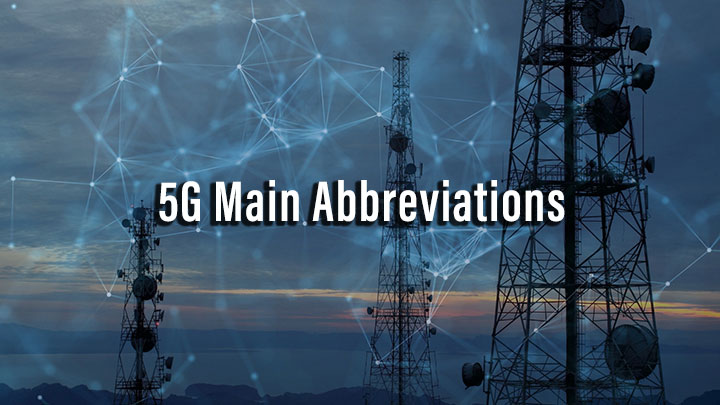3GPP 3rd generation partnership program
5G-GUTI 5G globally unique temporary identity
5G-AN 5G access network
5GC 5G core network
5GMM 5G mobility management
5GSM 5G session management
5GTF 5G technical Forum
5QI 5G QoS identifier
AAA Authentication, authorization and acounting
ACK Acknowledgement
AKA Authentication and key agreement
AM Acknowledged mode
AMBR Aggregate maximum bit rate
AMC Adaptive modulation and coding
AMD Acknowledge mode data
AMF Access and mobility management function
AN Access network
APN Access point name
ARFCN Absolute radio frequency channel number
ARP Address resolution protocol,
Allocation and retention priority as QoS parameter
ARPF Authentication credential respository and processing
function
ARQ Automatic repeat request
AS Access stratum
ASN.1 Abstract syntax notation one
AUSF: Authenticaton server function
AUTN Authentication token
AWGN Additive white gaussian noise
B
BA Bandwidth adaptation
BBU Baseband unit
BCCH Broadcast control channel (logical channel)
BCH Broadcast channel (transport channel)
BLER Block error rate
BPSK Binary phase shift keying
BS Base station
BSD Bucket size duration
BSMC Binary-input symmetric memoryless channel
BSR Buffer status report
BWP Bandwidth part
C
C-RNTI Cell RNTI
CA Carrier aggregation
CATR Compact antenna test range
CBG Code block group
CBRA Contention based random access
CCCH Common control channel
CCE Control channel element
CD-SSB Cell defining SSB
CDM Code division multiplex
CDMA Code division multiple access
CE Control element
CFO Carrier-frequency offset
CFRA Contention free random access
CID Context identifier
CK Ciphering key
CMAS Commercial mobile alert service
CoMP Coordinated multipoint
CORESET Control-resource set
CP Cyclic prefix – or – control plane
CP-OFDM Cyclic prefix OFDM
CP-OFDMA Cyclic prefix OFDMA
CPE Customer premises equipment
CQI Channel quality indicator
CRB Common resource block
CRC Cyclic redundancy check
CRI CSI-RS resource indicator
CRS Cell specific reference signals (LTE)
CS Configured scheduling
CS-RNTI Configured scheduling RNTI
CSI Channel-state information
CSI-IM CSI interference measurement
CSI-RS Channel-state information reference signal
CSI-RSRP CSI reference signal received power
CSI-RSRQ CSI reference signal received quality
CSI-SINR CSI reference signal to noise and interference ratio
CSS Common search space
CW Continuous wave
D
D2D Device to device
DC Dual connectivity or direct current
DCCH Dedicated control channel
DCI Downlink control information
DFF Direct far field
DFT Discrete fourier transformation
DFT-s-OFDM Discrete fourier transform-spread-orthogonal frequency
division multiplexing
DL Downlink
DL-SCH Downlink shared channel
DMRS Demodulation reference symbols
DN-AAA Data network authentication, authorisation and
accounting
DNN Data network name
DRB Data radio bearer
DRX Discontinuous reception
DTCH Dedicated traffic channel
DUT Device under test
E
E-RAB EUTRAN radio access bearer
EAP Extensible authentication protocol
EARFCN EUTRA ARFCN
ECGI EUTRAN cell global identity
ECM EPS connection management
EHPLMN Equivalent home public land mobile network
eMBB Enhanced mobile broadband
EMM EPS mobility management
eMTC Enhanced machine type communication
EN-DC EUTRA NR dual connectivity
eNB EUTRAN NodeB
EPC Evolved packet core
EPRE Energy per resource element
EPS Evolved packet system
ESM EPS session management
ETWS Earthquake and tsunami warning system
EUTRA Evolved universal terrestrial radio access
EUTRAN Evolved universal terrestrial radio access network
EVM Error vector magnitude
F
FDD Frequency division duplex
FDL Frequency downlink
FDMA Frequency division multiple access
FEC Forward error correction
FFS For further study
FGI Feature group indicator
FMC First missing count – used in PDCP status report
FR1 Frequency range 1
FR2 Frequency range 2
FUL Frequency uplink
FWA Fixed wireless access
G
GBR Guaranteed bit rate
GCF Global certification forum
GERAN GSM/EDGE radio access network
GF Grant-free
GFBR Guaranteed flow bit rate
GMSK Gaussian minimum shift keying
gNB NR NodeB
GNSS Global navigation satellite system
GPRS General packet radio services
GSCN Global synchronization channel number
GSM Global system for mobile communications
GTP GPRS tunneling protocol
GUTI Globally unique temporary UE identity
GW Gateway
HARQ Hybrid automatic repeat request
HFN Hyper frame number
HSDPA High speed downlink packet access – 3GPP Rel. 5
HSPA High speed packet access –
using HSDPA in downlink and HSUPA in uplink
HSS Home subsciber server
HSUPA High speed uplink packet access – 3GPP Rel. 6
I ICI Inter-carrier interference
IE Information element
IEI Information element identifier
IETF Internet engineering task force
IFF Indirect far field
IFFT Inverse fast fourier transformation
IK Integrity key
IMEI International mobile equipment identity
IMSI International mobile subscriber identity
INT-RNTI Interruption RNTI
IP Internet protocol
ISI Inter-symbol interference
ITU International telecommunication union
K
kB Kilobyte (1000 bytes)
KDF Key derivation function
KPI Key performance indicator
L
L2 Layer 2 (data link layer)
L3 Layer 3 (network layer)
LAN Local area network
LCG Logical channel group
LCID Logical channel ID – MAC header parameter
LCP Logical channel prioritization
LDPC Low density parity check
LI Layer indicator
LOS Line of sight
LSB Least significant bits
LTE Long term evolution
MBMS Multimedia broadcast and messaging services
MCC Mobile country code
MCG Master cell group
MCS Modulation and coding scheme
MCS-C-RNTI Modulation and coding scheme C-RNTI
MEC Mobile edge computing
MFBR Maximum flow bit rate
MIB Master information block
MICO Mobile initiated connection only
MIMO Multiple input multiple output
mIoT Massive internet of things
MME Mobility management entity
mMTC Massive machine type communications
MN Master node
MNC Mobile network code
MPA Message passing algorithm
MPP Multipath propagation
MR-DC Multi-radio dual connectivity
MSB Most significant bits
MSI Minimum system information
MTC Machine type communication,
Measurement timing configuration
MU-MIMO Multi-user MIMO
N
N3IWF Non-3GPP interworking functions
NAI Network access identifier
NAS Non-access stratum
NCC Next hop chaining counter or network color code
NCGI NR cell global identifier
NCR Neighbour cell relation
NDI New data indicator
NF network function
NG-RAN NG radio access network
NGAP NG application protocol
ng-eNB next generation evolved NodeB
NH Next hop
NLOS Non line of sight
NR New radio
NSA Non-standalone
NSSAI Network slice selection assistance information
NW Network
NZP CSI-RS Non zero power CSI-RS
O OFDM Orthogonal frequency division multiplexing
OFDMA Orthogonal frequency division multiple access
OSI Open system interconnection,
Other system information
P P-GW Packet gateway
P-RNTI Paging RNTI
PAPR Peak-to-average power ratio
PBCH Physical broadcast channel
PBR Prioritised bit rate
PCCH Paging control channel
PCell Primary cell
PCF Policy control function
PCH Paging channel
PCI Physical cell identity
PCRF Policy control and routing function
PDB Packet delay budget
PDCCH Physical downlink control channel
PDCP Packet data convergence protocol
PDSCH Physical downlink shared channel
PDU Protocol data unit
PER Packet error rate
PH Power headroom
PHICH Physical hybrid indicator channel
PHR Power headroom report
PL Path loss
PLL Phase locked loop
PLMN Public land mobile network
PMI Precoding matrix indication
PRACH Physical random access channel
PRB Physical resource block
PRG Precoding resource block group
PSS Primary synchronisation signal
PTRS Phase tracking reference signal
PTAG Primary timing advance group
PTRS Phase tracking reference signal
PUCCH Physical uplink control channel
PUSCH Physical uplink shared channel
PWC Plane wave converter
PWS Public warning system
Q QAM Quadrature amplitude modulation
QCI QoS class identifier
QCL Quasi co-location
QFI QoS flow ID
QoS Quality of service
QPSK Quadrature phase shift keying
QZ Quite zone
RR
A-RNTI Random access radio network temporary identifier
RACH Random access channel
RAN Radio access network
RAPID Random access preamble identifier
RAR Random access response (Msg2)
RAT Radio access technology
RB Radio bearer or resource block
RBG Resource block group
RDI Reflective QoS flow to DRB mapping indication
REG Resource element group
RF Radio frequency
RFC Request for comments
RI Rank indicator
RIV Resource indicator value
RLC Radio link control
RMSI Remaining minimum system information
RNA RAN-based notification area
RNAU RAN-based notification area update
RNTI Radio network temporary identifier
ROHC Robust header compression
RQA Reflective QoS attribute
RQI Reflective QoS indication
RQoS Reflective quality of service
RRC Radio resource control
RRH Remote radio head
RRU Remote radio unit
RSRP Reference signal received power
RSSI Received signal strength indicator
RTP Real time protocol
RTT Round trip time
RU Radio unit
RV Redundancy version
S
S-GW Serving gateway
S-NSSAI Single network slice selection assistance information
SA Standalone
SAE Service architecture evolution
SAP Service access point
SC-FDMA Single carrier FDMA
SCell Secondary cell
SCG Secondary cell group
SCH Shared channel
SCS Subcarrier spacing
SCTP Stream control transmission protocol
(defined in RFC 4960)
SD Slice differentiator
SDAP Service data adaptation protocol
SDF Service data flow
SDL Supplementary downlink
SDU Service data unit
SEAF Security anchor function
SFI-RNTI Slot format indicator RNTI
SFN System frame number
SI System information
SI-RNTI System information radio network temporary identifier
SIB System information block
SIM Subscriber identity module
SINR Signal-to-interference-plus-noise ratio
SISO Single input single output
SLA Service level agreement
SLIV Start and length value
SMF Session management function
SN Sequence number
Secondary node
SNR Signal to noise ratio
SpCell Special cell
SPS Semi-persistent scheduling
SQN Sequence number (ciphering)
SR Scheduling request
SRB Signalling radio bearer
SRS Sounding reference signal
SS Synchronization signal
SSB Synchronization signal block
SSBRI SS/PBCH block resource indicator
SSC Session and service continuity
SSF Slice selection function
SSS Secondary synchronisation signal
SST Slice/service type
STAG Secondary timing advance group
SU-MIMO Single user MIMO, also referred to as
spatial multiplexing
SUL Supplementary uplink
SUPI Subscription permanent identifier
T
T&M Test & measurement
TA Timing advance or tracking area
TAG Timing advance group
TB Transport block
TBS Transport block size
TCI Transmission configuration indicator
TCP Transmission control protocol
TC-RNTI Temporary cellular radio network temporary identifier
TDD Time division duplex
TDMA Time division multiplex access
TM Transparent mode
TNL Transport network layer
TPC Transmit power control
TPC-CS-RNTI TPC configured scheduling-RNTI
TPC-PUCCH-RNTI TPC physical uplink control channel-
RNTI
TPC-PUSCH-RNTI TPC physical uplink shared channel-
RNTI
TPC-SRS-RNTI TPC sounding reference symbols-RNTI
TPMI Transmit precoding matrix indicator
TRP Transmission and reception point
TRS Tracking reference signal
TTCN-3 Testing and test control notation version 3
TTI Transmission time interval
U
UCI Uplink control information
UDM Unified data management
UDP User datagram protocol
UE User equipment
UICC Universal integrated circuit card
UL Uplink
UL-SCH Uplink shared channel
UM Unacknowledged mode
UMTS Universal mobile telecommunication system
UP User plane
UPF User plane function
URLLC Ultra-reliable and low latency communications
USIM UMTS subscriber identity module
V
V2X Vehicle to x communication
VCO Voltage controlled oscillator
VNA Vector network analyzer
VRB Virtual resource block
W
WLAN Wireless LAN
X
X2 The interface between the eNBs
X-MAC Computed MAC-I
xNB Either NR NodeB or EUTRA NodeB
Xn The interface between the gNBs
Xn-C Xn-Control plane
Xn-U Xn-User plane
XnAP Xn application protocol
XRES Expected response
Z
ZF Zero forcing equalization
ZP CSI-RS Zero power CSI-RS







